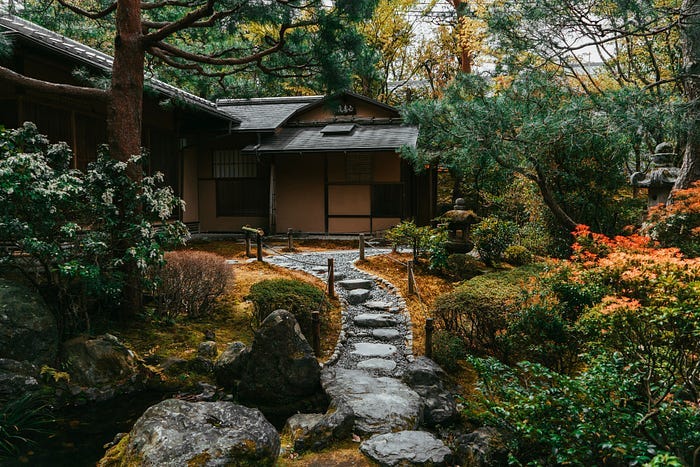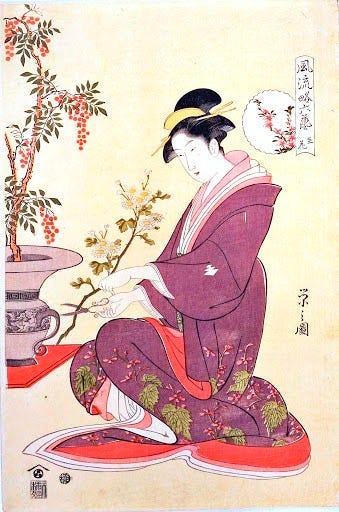How To Improve Your Life By Practicing The Japanese Concept Of Dō
The lifelong pursuit of a mind-body skill is the path

“Dō expresses progress in the practice of an art, whatever it may be. Indeed, the kanji is particularly used in traditional Japanese arts, whether martial arts or aesthetic arts. So kado 花道, is ‘the way of flowers’, that is, the art of flower arranging... Shodo 書道, ‘the way of writing’, is the art of calligraphy. Kyudo 弓道 is ‘the way of the bow’, or Japanese archery. And kendo 剣道, the martial art using bamboo swords, is ‘the way of the sword’. Some words also refer to religious or philosophical doctrines, such as Shinto, literally ‘the way of god’”.
I’m sure you’ve noticed society’s recent self-improvement craze. Everyone has a different quick path to excellence to sell you. Everything from meditation, journaling, gratitude, and countless books are promoted to us to help on this journey. Modern society understands methods of consumer-driven products and their associated marketing campaigns; so, self-improvement is sold and packaged that way.
However, self-improvement has been around much longer than our modern age. The Japanese had and still have a much different path to the excellence we seek. It didn’t come packaged with an “easy to follow” instruction manual. Their method of dō comes intertwined with an art and is seen as a long path. In fact, it can translate as “the way”.
Their method is a never-ending road to the excellence we all seek. What’s more, the practice of self-improvement is almost shrouded in the art you seek to improve on. The skill becomes a practice lasting a lifetime or shugyō, and with it your efforts to better yourself. Unfortunately, this method can’t be packaged into a slick 30-second marketing campaign, but it may be able to continuously improve your life over decades.
Striving To Improve The Sword
Professor Jesús Ilundáin-Agurruza in his scholarly article “Reflections on a Katana — The Japanese Pursuit of Performative Mastery” describes the first Mongol invasion of Japan in the 13th century. Japan had no natural metallurgical skills, and their poorly copied Chinese swords didn’t stand up well to the stress of battle. By the time the Mongols came again, the invaders faced samurai carrying the awe-inspiring katana.
Agurruza uses this as a metaphor to describe the essence of dō along with the nature of Japan historically and culturally. The island has no natural resources or original technology, so most had to be imported. However, they had this incredible ability to greatly enhance everything they borrowed, infusing it with never-ending improvement — making it their own. Hence poor-quality swords can become katanas and poorly crafted lives likewise can become excellent.
The professor mentions several references where Japanese historical figures compare the making of character or personal excellence to a honed skill like sword making or metallurgy. He quotes the founder of Aikido, Morihei Ueshiba , saying, “iron is full of impurities that weaken it, through forging, it becomes steel and is transformed into a razor-sharp sword. Human Beings develop in the same fashion.”
Another sword maker who continues to make katanas in the traditional fashion mentions a single blade must be polished frequently every day for months at a time. The craftsman mentions each time he polishes the sword, it’s like “polishing his soul”. So, the skill is more than making a sword; the intense practice and concentration also help forge a life.
Striving To Improve Ourselves

“…Following the path of a dō means engaging an enlightening practice reflectively and with full dedication. And this, for a long time — ideally for a lifetime.”
— Professor Jesús Ilundáin-Agurruza, “Reflections on a Katana — The Japanese Pursuit of Performative Mastery”
Often in Western philosophy, improvement of the self or character is done by specific mental practices. However, the concept of dō encapsulates the improvement of mind and character within the practice of an engrossing art. This art can be physical, like a martial art, or more conceptual like calligraphy or flower arranging.
The continuous study, improvement, and work teaches you lessons which can’t be learned in a book. Like the sword maker mentions, it’s a polishing of the soul. The physical path may only look like a manifestation in the visual world, but something much deeper is happening. A spiritual excellence is being crafted along with the physical art.
This can’t happen quickly. A katana isn’t polished overnight, and a traditional Japanese garden isn’t set up in a weekend. These are practices that demand time, reverence, and concentration. Many of these Japanese arts, such as flower arranging, calligraphy, archery, and the sword often mix Zen teaching within the art as well.
While this thought process may not completely line up with Western philosophy, it’s not totally alien to it. A famous quote attributed to Aristotle, but really by the historian Will Durant says, “We are what we repeatedly do. Excellence, then, is not an act, but a habit.” The ancient Roman stoics also used archery to teach philosophical concepts as well. Both sound very similar to dō.
Another Way To Improvement
Marketing and packaging are a good way to sell products. They can put a cookie-cutter self-help book or program into your hands promising instant results and excellence. However, are instant results what you really need? Japanese artisans believed in a different path — a very long one. Their path wasn’t a ready-made microwavable one either.
Their concept of dō involved taking up a consuming art and investing yourself in it over your lifetime. The practice and continuing striving for excellence in the art permeated itself into your soul and character. The art doesn’t matter. Whether you hold a pen, flower, or sword in your hand isn’t the point. The endless pursuit is all that matters.
Maybe this is what we’re missing today. Maybe this is why there are endless self-help programs and endless people to buy them. We may be better off signing up for a calligraphy class or a martial art. But whatever the dō you choose, make it a long one and one that demands your entire self.
Perhaps we should reword the old Western saying: you are what you repeatedly dō.


